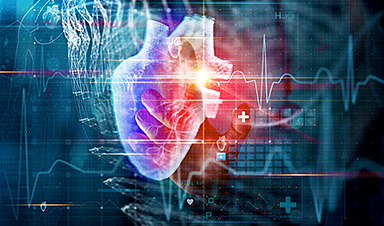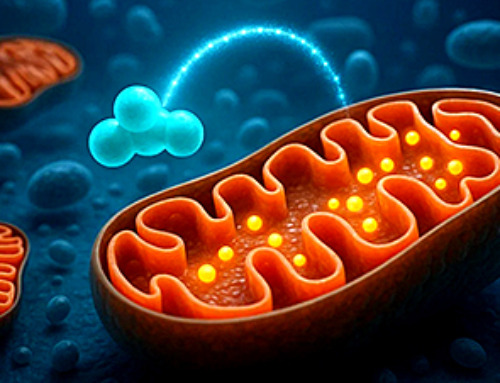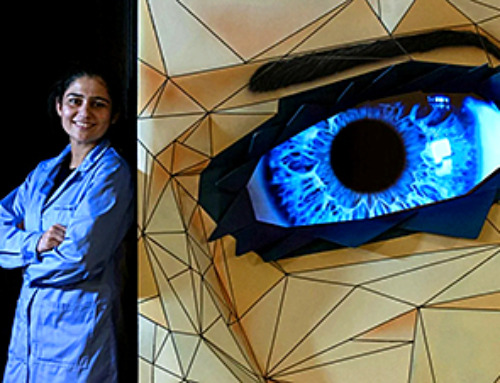- AI is so energy-hungry that most data analysis must be performed in the cloud
- New energy-efficient device enables AI tasks to be performed within wearables
- This allows real-time analysis and diagnostics for faster medical interventions
- Researchers tested the device by classifying 10,000 electrocardiogram samples
- The device successfully identified six types of heartbeats with 95% accuracy
Innovative Nanoelectronic Device for Efficient Machine Learning
Forget the cloud.
Northwestern University engineers have developed a new nanoelectronic device that can perform accurate machine-learning classification tasks in the most energy-efficient manner yet. Using 100-fold less energy than current technologies, the device can crunch large amounts of data and perform artificial intelligence (AI) tasks in real-time without beaming data to the cloud for analysis.
With its tiny footprint, ultra-low power consumption, and lack of lag time to receive analyses, the device is ideal for direct incorporation into wearable electronics (like smartwatches and fitness trackers) for real-time data processing and near-instant diagnostics.
Test and Application
To test the concept, engineers used the device to classify large amounts of information from publicly available electrocardiogram (ECG) datasets. Not only could the device efficiently and correctly identify an irregular heartbeat, it also was able to determine the arrhythmia subtype from among six different categories with nearly 95% accuracy.
The research will be published today (October 12) in the journal Nature Electronics.
Conventional vs. New Approach
“Today, most sensors collect data and then send it to the cloud, where the analysis occurs on energy-hungry servers before the results are finally sent back to the user,” said Northwestern’s Mark C. Hersam, the study’s senior author. “This approach is incredibly expensive, consumes significant energy and adds a time delay. Our device is so energy efficient that it can be deployed directly in wearable electronics for real-time detection and data processing, enabling more rapid intervention for health emergencies.”
A nanotechnology expert, Hersam is Walter P. Murphy Professor of Materials Science and Engineering at Northwestern’s McCormick School of Engineering. He also is chair of the Department of Materials Science and Engineering, director of the Materials Research Science and Engineering Center, and member of the International Institute of Nanotechnology. Hersam co-led the research with Han Wang, a professor at the University of Southern California, and Vinod Sangwan, a research assistant professor at Northwestern.
Technological Challenges and Breakthroughs
Before machine-learning tools can analyze new data, these tools must first accurately and reliably sort training data into various categories. For example, if a tool is sorting photos by color, then it needs to recognize which photos are red, yellow, or blue in order to accurately classify them. An easy chore for a human, yes, but a complicated — and energy-hungry — job for a machine.
For current silicon-based technologies to categorize data from large sets like ECGs, it takes more than 100 transistors — each requiring its own energy to run. However, Northwestern’s nanoelectronic device can perform the same machine-learning classification with just two devices. By reducing the number of devices, the researchers drastically reduced power consumption and developed a much smaller device that can be integrated into a standard wearable gadget.
The secret behind the novel device is its unprecedented tunability, which arises from a mix of materials. While traditional technologies use silicon, the researchers constructed the miniaturized transistors from two-dimensional molybdenum disulfide and one-dimensional carbon nanotubes. So instead of needing many silicon transistors — one for each step of data processing — the reconfigurable transistors are dynamic enough to switch among various steps.
“The integration of two disparate materials into one device allows us to strongly modulate the current flow with applied voltages, enabling dynamic reconfigurability,” Hersam said. “Having a high degree of tunability in a single device allows us to perform sophisticated classification algorithms with a small footprint and low energy consumption.”
Practical Testing and Future Prospects
To test the device, the researchers looked to publicly available medical datasets. They first trained the device to interpret data from ECGs, a task that typically requires significant time from trained healthcare workers. Then, they asked the device to classify six types of heartbeats: normal, atrial premature beat, premature ventricular contraction, paced beat, left bundle branch block beat, and right bundle branch block beat.
The nanoelectronic device was able to identify accurately each arrhythmia type out of 10,000 ECG samples. By bypassing the need to send data to the cloud, the device not only saves critical time for a patient but also protects privacy.
“Every time data are passed around, it increases the likelihood of the data being stolen,” Hersam said. “If personal health data is processed locally — such as on your wrist in your watch — that presents a much lower security risk. In this manner, our device improves privacy and reduces the risk of a breach.”
Hersam imagines that, eventually, these nanoelectronic devices could be incorporated into everyday wearables, personalized to each user’s health profile for real-time applications. They would enable people to make the most of the data they already collect without sapping power.
“Artificial intelligence tools are consuming an increasing fraction of the power grid,” Hersam said. “It is an unsustainable path if we continue relying on conventional computer hardware.”
Reference: “Reconfigurable mixed-kernel heterojunction transistors for personalized support vector machine classification” 12 October 2023, Nature Electronics.
DOI: 10.1038/s41928-023-01042-7
The study was supported by the U.S. Department of Energy, National Science Foundation, and Army Research Office.
News
This Tiny Cellular Gate Could Be the Key to Curing Cancer – And Regrowing Hair
After more than five decades of mystery, scientists have finally unveiled the detailed structure and function of a long-theorized molecular machine in our mitochondria — the mitochondrial pyruvate carrier. This microscopic gatekeeper controls how [...]
Unlocking Vision’s Secrets: Researchers Reveal 3D Structure of Key Eye Protein
Researchers have uncovered the 3D structure of RBP3, a key protein in vision, revealing how it transports retinoids and fatty acids and how its dysfunction may lead to retinal diseases. Proteins play a critical [...]
5 Key Facts About Nanoplastics and How They Affect the Human Body
Nanoplastics are typically defined as plastic particles smaller than 1000 nanometers. These particles are increasingly being detected in human tissues: they can bypass biological barriers, accumulate in organs, and may influence health in ways [...]
Measles Is Back: Doctors Warn of Dangerous Surge Across the U.S.
Parents are encouraged to contact their pediatrician if their child has been exposed to measles or is showing symptoms. Pediatric infectious disease experts are emphasizing the critical importance of measles vaccination, as the highly [...]
AI at the Speed of Light: How Silicon Photonics Are Reinventing Hardware
A cutting-edge AI acceleration platform powered by light rather than electricity could revolutionize how AI is trained and deployed. Using photonic integrated circuits made from advanced III-V semiconductors, researchers have developed a system that vastly [...]
A Grain of Brain, 523 Million Synapses, Most Complicated Neuroscience Experiment Ever Attempted
A team of over 150 scientists has achieved what once seemed impossible: a complete wiring and activity map of a tiny section of a mammalian brain. This feat, part of the MICrONS Project, rivals [...]
The Secret “Radar” Bacteria Use To Outsmart Their Enemies
A chemical radar allows bacteria to sense and eliminate predators. Investigating how microorganisms communicate deepens our understanding of the complex ecological interactions that shape our environment is an area of key focus for the [...]
Psychologists explore ethical issues associated with human-AI relationships
It's becoming increasingly commonplace for people to develop intimate, long-term relationships with artificial intelligence (AI) technologies. At their extreme, people have "married" their AI companions in non-legally binding ceremonies, and at least two people [...]
When You Lose Weight, Where Does It Actually Go?
Most health professionals lack a clear understanding of how body fat is lost, often subscribing to misconceptions like fat converting to energy or muscle. The truth is, fat is actually broken down into carbon [...]
How Everyday Plastics Quietly Turn Into DNA-Damaging Nanoparticles
The same unique structure that makes plastic so versatile also makes it susceptible to breaking down into harmful micro- and nanoscale particles. The world is saturated with trillions of microscopic and nanoscopic plastic particles, some smaller [...]
AI Outperforms Physicians in Real-World Urgent Care Decisions, Study Finds
The study, conducted at the virtual urgent care clinic Cedars-Sinai Connect in LA, compared recommendations given in about 500 visits of adult patients with relatively common symptoms – respiratory, urinary, eye, vaginal and dental. [...]
Challenging the Big Bang: A Multi-Singularity Origin for the Universe
In a study published in the journal Classical and Quantum Gravity, Dr. Richard Lieu, a physics professor at The University of Alabama in Huntsville (UAH), which is a part of The University of Alabama System, suggests that [...]
New drug restores vision by regenerating retinal nerves
Vision is one of the most crucial human senses, yet over 300 million people worldwide are at risk of vision loss due to various retinal diseases. While recent advancements in retinal disease treatments have [...]
Shingles vaccine cuts dementia risk by 20%, new study shows
A shingles shot may do more than prevent rash — it could help shield the aging brain from dementia, according to a landmark study using real-world data from the UK. A routine vaccine could [...]
AI Predicts Sudden Cardiac Arrest Days Before It Strikes
AI can now predict deadly heart arrhythmias up to two weeks in advance, potentially transforming cardiac care. Artificial intelligence could play a key role in preventing many cases of sudden cardiac death, according to [...]
NanoApps Medical is a Top 20 Feedspot Nanotech Blog
There is an ocean of Nanotechnology news published every day. Feedspot saves us a lot of time and we recommend it. We have been using it since 2018. Feedspot is a freemium online RSS [...]





















